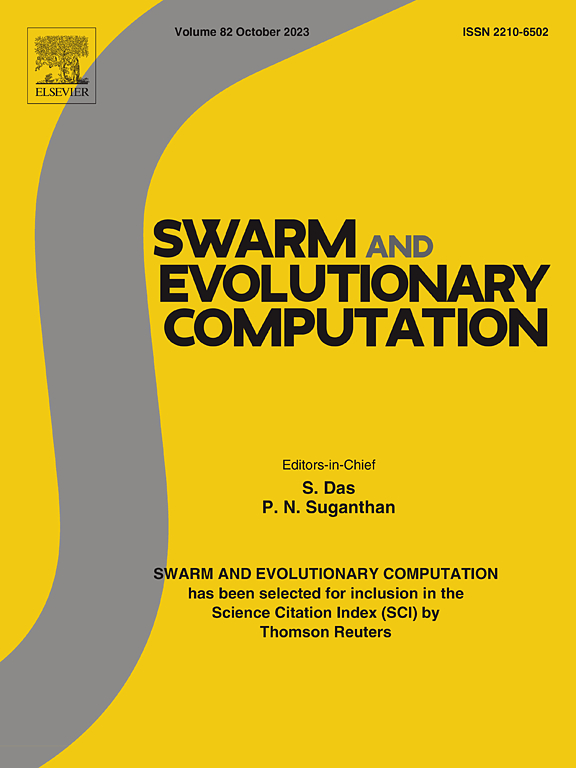面向二层定位和延迟的路由问题的代理辅助进化算法
IF 8.2
1区 计算机科学
Q1 COMPUTER SCIENCE, ARTIFICIAL INTELLIGENCE
引用次数: 0
摘要
供应链中不同利益相关者之间的层次结构是常见的,不应忽视。在本研究中,我们在供应链框架内解决了位置和路由决策。具体来说,我们关注的是一个现实生活中涉及两个利益相关者的问题:一个(领导者)负责确定仓库的位置和大小,另一个(追随者)负责向客户交付产品。领导者的目标是最小化成本,而追随者的目标是最小化延迟,这被解释为沿路线的客户等待时间。为了解决这种分层情况,我们提出了一种新的双层优化模型。该模型的复杂性,包括每个级别的二元和连续变量,并且由于建模客户延迟的多层次网络而具有高维性,排除了使用单级别重新制定。因此,我们提出一种进化算法来解决双层问题。考虑到追随者问题的挑战性,经典的嵌套方法将非常耗时。因此,我们使用代理方法来近似面向延迟的路由决策过程,并将它们集成到进化算法的框架中。这种方法提供了一种处理复杂性的有效方法,同时保持了双层解决方案的可行性。代理策略是基于一组学习模型,这些模型是由来自两层可行解决方案的有限数据训练而成。研究了几种变体,并与最先进的代理算法进行了比较,以更少的计算时间获得了更好的结果。本文章由计算机程序翻译,如有差异,请以英文原文为准。
Surrogate-assisted evolutionary algorithms for a bilevel location and latency-oriented routing problem
Hierarchies among different stakeholders within a supply chain are common and should not be overlooked. In this study, we address both location and routing decisions within the supply chain framework. Specifically, we focus on a problem inspired by a real-life situation involving two stakeholders: one (the leader) responsible for determining the location and size of depots, and another (the follower) responsible for delivering products to customers. The leader aims to minimize costs, while the follower seeks to minimize latency, which is interpreted as the waiting time of customers along the routes. To address this hierarchical situation, we propose a novel bilevel optimization model. The complexity of this model, which includes both binary and continuous variables at each level and features high dimensionality due to a multi-level network accounting for modeling customers’ latency, precludes the use of a single-level reformulation. Therefore, we propose an evolutionary algorithm to solve the bilevel problem. Given the challenging nature of the follower’s problem, a classical nested approach would be excessively time-consuming. Thus, we employ surrogate methods to approximate the latency-oriented routing decision process, integrating them into the evolutionary algorithm’s framework. This approach provides an effective means of addressing the complexities while maintaining the feasibility of the bilevel solutions. The surrogate strategy is based on a committee of learning models trained on limited data from bilevel feasible solutions. Several variants are studied and compared against state-of-the-art surrogate algorithms, obtaining better results with less computational time for the problem under study.
求助全文
通过发布文献求助,成功后即可免费获取论文全文。
去求助
来源期刊

Swarm and Evolutionary Computation
COMPUTER SCIENCE, ARTIFICIAL INTELLIGENCEC-COMPUTER SCIENCE, THEORY & METHODS
CiteScore
16.00
自引率
12.00%
发文量
169
期刊介绍:
Swarm and Evolutionary Computation is a pioneering peer-reviewed journal focused on the latest research and advancements in nature-inspired intelligent computation using swarm and evolutionary algorithms. It covers theoretical, experimental, and practical aspects of these paradigms and their hybrids, promoting interdisciplinary research. The journal prioritizes the publication of high-quality, original articles that push the boundaries of evolutionary computation and swarm intelligence. Additionally, it welcomes survey papers on current topics and novel applications. Topics of interest include but are not limited to: Genetic Algorithms, and Genetic Programming, Evolution Strategies, and Evolutionary Programming, Differential Evolution, Artificial Immune Systems, Particle Swarms, Ant Colony, Bacterial Foraging, Artificial Bees, Fireflies Algorithm, Harmony Search, Artificial Life, Digital Organisms, Estimation of Distribution Algorithms, Stochastic Diffusion Search, Quantum Computing, Nano Computing, Membrane Computing, Human-centric Computing, Hybridization of Algorithms, Memetic Computing, Autonomic Computing, Self-organizing systems, Combinatorial, Discrete, Binary, Constrained, Multi-objective, Multi-modal, Dynamic, and Large-scale Optimization.
 求助内容:
求助内容: 应助结果提醒方式:
应助结果提醒方式:


